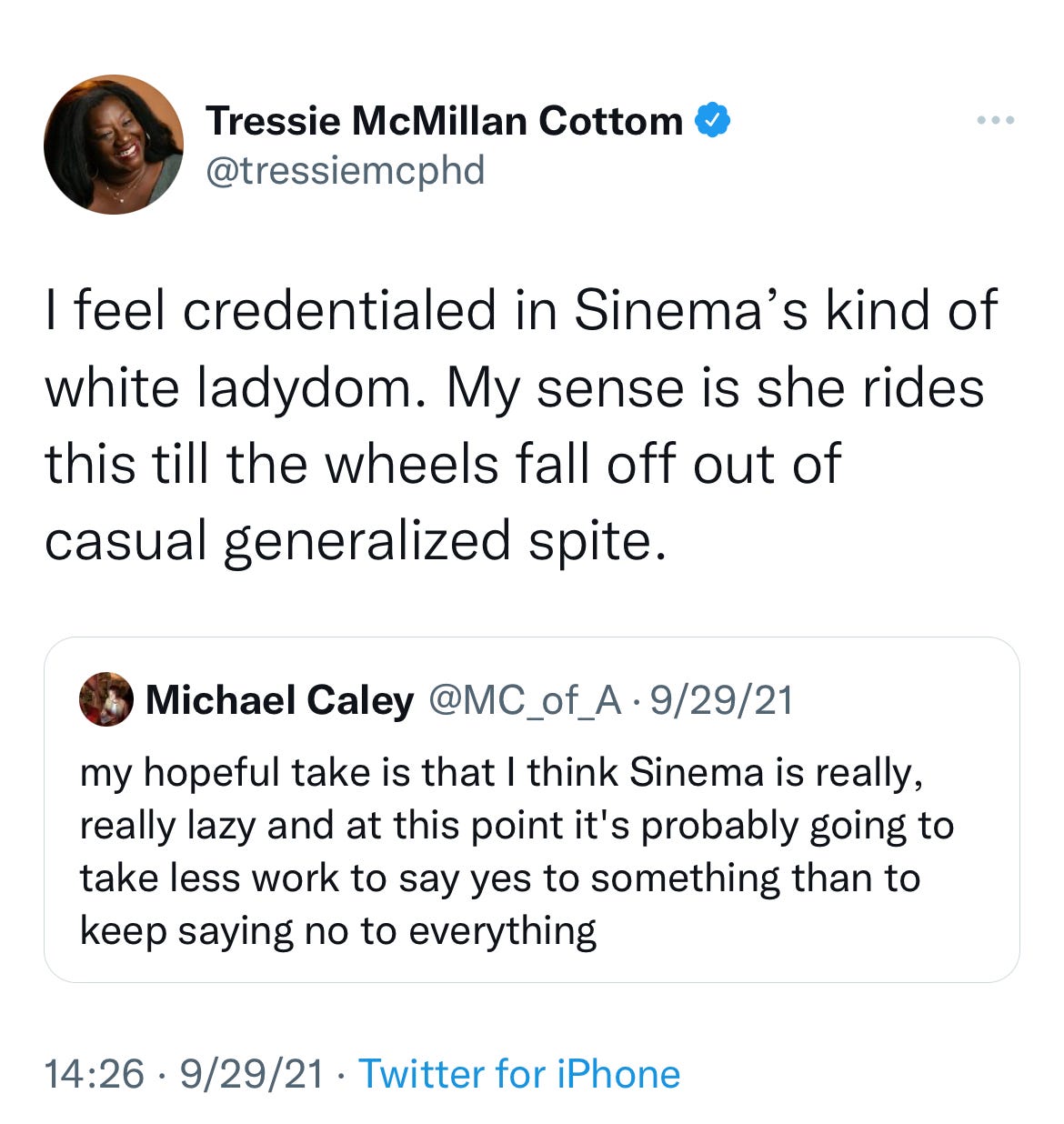"Mean Girl Shit," Dressed Up As Social Commentary: The Mocking of Kyrsten Sinema
(Kyrsten Sinema presiding over the Senate, October 2021)
Over this past month, the New York Times has run a series of columns on the inscrutable fashion choices of Arizona’s senior senator, Kyrsten Sinema. In a yet-to-be-concluded series (three so far), Tressie McMillan Cottom (a professor at the University of North Carolina) has been offering one observation after another about how Sinema presents herself.
To the contemporary American left Sinema is anathema. A one-time progressive activist in Arizona, she’s taken a turn to the right since her election to the Senate in 2018. Along with Joe Manchin of West Virginia, Sinema is one of the two Democratic moderates in the upper chamber – and one of the two main obstacles to the passage of the massive Build Back Better Act.
Manchin is a familiar figure in American politics – a “Blue Dog” conservative Democrat, a regular on Sunday talk shows, a keen advocate for the interests of his state. His accent is the sort that urban sophisticates love to mock. (I remember a late relative, a daughter of San Francisco society, who remarked that while she had admired LBJ greatly, she had had to turn off the TV or radio whenever he spoke. His Texas accent hurt her cultivated heart; “It’s dreadful when a president just sounds so ignorant.”) Liberals have a long narrative about white Southern male Senators, and with his drawl, his reverence for Senate rules, and his evident self-interest, Joe Manchin is easy for most in Brooklyn or Brentwood to imagine they understand, if not admire.
Sinema is the woman who is supposed to know better. She’s come out as bisexual! She railed against climate indifference as an activist! She’s comparatively young! Why is she voting like Joe Manchin, and not like Elizabeth Warren? So much of the left’s fury has been directed at Sinema because she confounds the narrative; Manchin’s the grumpy old dog who can’t be expected to learn a new trick, but Sinema should be the fierce new pup, barking out the requisite progressive line.
It doesn’t help that where Manchin is garrulous, with a typical Senator’s inability to resist a hot microphone, Sinema keeps her own counsel, rarely doing interviews. She won’t tell us why she won’t play along, or why she thinks as she does, so the Times has decided we must launch a multi-part series to examine her body and her fashion choices for clues to the origin and meaning of her bizarre obstreperousness.
Cottom began her first piece on Sinema by defending the project:
We have gotten the message that good people simply do not comment on how people look because that can be rife with bias. The problem with that response is that the bias still happens — we just do not name it. When you “don’t comment on bodies,” you lose the discernment to think critically about how some bodies move through the world at the expense of how other bodies can move through the world. In short, when our language atrophies, we lose the mental acuity to talk about how power operates in our everyday life.
On the one hand, it’s a good point. We do judge people by what they wear, but in a culture where that’s considered bad manners, our judgments stay silent in polite society. Our refusal to examine our own prejudices allows them to endure. We should talk about fashion and beauty standards, not necessarily to dismantle their power but to, if nothing else, get a better understanding of why we feel compelled to dress and judge as we do. On the other hand, it’s a big leap to presume that if “some bodies move at the expense of other bodies,” an analysis of Kyrsten Sinema’s unconventional color palette will somehow lead us to a more just society.
More to the point, Cottom is the wrong person to do this analysis, largely because her contempt for her subject is clear. A month before her Times series on Sinema’s clothing began, she tweeted this:
Now that we have Professor Cottom’s credentials established, and we have her diagnosis — “casual generalized spite” — little remains except for the Times to print several thousand words explaining how that casual spite is made manifest in Sinema’s sleeveless denim jacket. To progressives confounded by Sinema, Cottom has an answer. I know this type of white lady. You don’t see them often in the Senate, but I grew up around ‘em, and they’re all snakes; watch while I dissect the poisonous serpent so you can better understand why it moves and hisses as it does.
Cottom contrasts Sinema with the most powerful woman in Congress, the invariably elegant and perfectly coiffed Nancy Pelosi. Pelosi, we are told, has a stylist on hand, and dresses to convey power and status. Kyrsten is no Nancy. Cottom notes that Sinema is the “poorest” of the nation’s 100 senators, and snarks:
“Sinema may not have the clout to hire a style consultant to smooth over her outfits’ competing messages. It’s a generous interpretation, and really the most generous one I can imagine.”
Oh, don’t worry. Cottom will share her less generous interpretations too.




